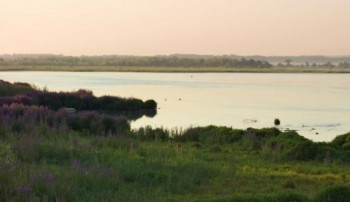The Gift of South Dakota
Subscriptions to South Dakota Magazine make great gifts!
Subscribe today — 1 year (6 issues) is just $29!
Yes We Can. No You Can't.
Dec 1, 2011
Yes, I'm a part-time politician. But I've always tried to not be a Corps-basher. I know a lot of good and caring people work for the big bureaucracy that dammed our favorite river. Many of them are friends and neighbors here in Yankton.
But only one word comes to mind to describe the two-hour meeting on Wednesday night (Nov. 30) at the Kelly Inn, a rifle shot away from the wild Missouri.
That word? Frustration.
Four Corps engineers came to report on a six-year study of the sedimentation problem on Lewis and Clark Lake. The lake was 25 miles long when Gavins Point Dam was built 60 years ago. Today it is 17 miles long. The upper portion has become a delta (the Corps word for it), or a swamp in layman's language.
Some 2,400 acre feet of water storage has been lost, which compounded the flooding this summer. That represents 22% of the lake's total capacity.
Sedimentation has already affected fish and wildlife species and the overall ecosystem. It will eventually damage water recreation and economic development. It is a serious problem.
So a hundred people — most of them, knowledgeable river rats who love the Missouri — gathered at the inn hoping for a vision. For answers. For leadership.
So at last comes the Corps study on sedimentation. Yes, we can flush the lake and remove sedimentation, said Paul Boyd, a hydraulic engineer. We can remove the silt and clay. The sand? That's another matter. It's really hard to move the sand out of the reservoir.
Paul Boyd speaks for an hour, showing graphs and charts of the computer modeling.
Then an old-timer in the rear of the room stands up and drawls, "How much of that .... delta ... at Springfield is sand and how much is silt and clay?"
It's mostly sand, said Mr. Boyd.
Furthermore, the lake would have to be almost entirely drained, then flushed with huge releases from Fort Randall Dam, and then refilled — all in a three-week cycle that would entail discharges of 88,000 to as high as 176,000 CFS. The latter is higher than the highest discharges this summer that overwhelmed the river valley, ruined farmland and destroyed homes and gardens. All of that to remove the silt and clay, which really isn't the problem.
There were not that many more questions. I am sure that everyone in the room — even those most in support of a sedimentation solution — were silently thinking, "is this all there is ... after a six-year study?"
The engineers stressed that they only asked the question of whether flushing would work. They didn't study the social, political, economic and environmental aspects.
I imagine that will take four more studies at six years each.
This is a country that built the Missouri River dams a scant two generations ago. We won two world wars and a cold war. We invented the threshing machine and the automobile and the internet. We made free education and home ownership not a dream but a right. And today it takes our federal government six years to say yes, we can flush the lake and flood your homes if you want us to?
Is it any wonder that we can't solve health care and school issues?
We need vision, both from the politicians and the bureaucrats. The hundred people at the inn were hungry for a path to progress. They left the room hungrier than when they came.
It reminds me of a study done in the late 19th century on how to solve the horse manure problem in New York City. Experts studied the problem and came to the conclusion that there were no reasonable solutions other than to reduce the size of the city population.
The Corps of Engineers needs to find a Henry Ford.











Comments
The Corp is overlooking an obviously simple solution that was brought to my attention.
It seems the T&E (Threatened and Endangered Species) department of the Corp has pretty much unlimited funds. Pump the sand from the lake into trucks that haul it to strategic locations below the dam so we can build more million dollar sandbars for the nesting terns and plovers.
Now, was that so hard?
One fellow last night suggested that they bag the sand and sell it in hardware stores to parents who are looking for sand for their kids' sand boxes.
At least the GSANDBOX5 plan wouldn't flood anyone's farm or home.